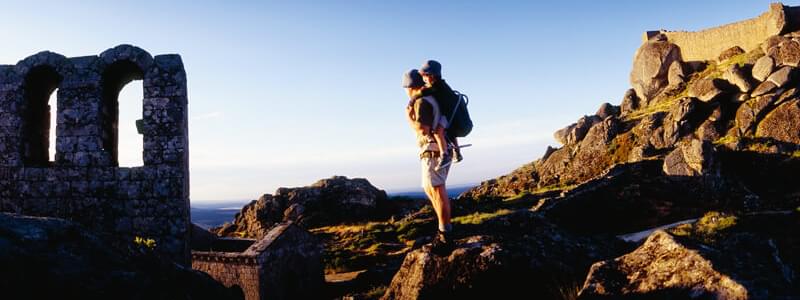Most of these fortifications are classified as national monuments and were the stage of some of the most important events which defined the History of the country. For centuries, their walls guarded the border from the attacks of enemy armies and, at the same time, they engraved the past and present of a people in stone.
Nowadays, they preserve the memory of the raiana region, tell the stories of their masters, whisper tales and mark the landscape with their medieval majestic architecture. Come and discover them at Alfaiates, Almeida, Belmonte, Castelo Bom, Castelo Mendo, Castelo Rodrigo, Guarda, Idanha-a-Velha, Monsanto, Penamacor, Penha Garcia, Pinhel, Sabugal, Sortelha and Vilar Maior.
Returning to Portuguese Past
It’s not difficult to go back in time when you stroll through a fortress with a 2500 meters wall, bend over a balcony where the enemy has been fought with boiling oil or hearing tales like that of the Butchered.
At the Border Castles you will be able to discover a world of stone and History which will bring the past back to you.
Discover Almeida and be amazed by the greatness of its fortress which becomes a twelve pointed star when seen from the sky. Stroll through the Belmonte walls which saw the birth of discoverer Pedro Álvares Cabral. Enter the Berrões Door at Castelo Mendo. Fall in love with the tales inside the Templars Tower at Idanha-a-Velha. Explore all Guarda Castle doors which are still spread through the narrow streets of the city. Dance and sing to the sound of timbrels at the Saint Cross Feast which, once a year, fills the walls of Monsanto. Visit the Pinhel virtual belvedere. Discover the unusual tower of the Five Quinas Castle, at Sabugal. Or you can follow the mountain tracks which will lead you to the Vilar Maior Castle.
Be amazed by the beauty of the raiana lands and their majestic fortifications which still seem to fulfil their purpose of defending the oldest border in Europe.
The oldest border in Europe
Portugal is the oldest state in Europe, dating back to the 12th century, when, in 1139, King Afonso Henriques declared the independence of the County of Portugal, definitely breaking away from the Kingdoms of Léon and Castile. The main goal of the first Kings of Portugal was to expand the borders of the new country which, at the time of its foundation, were limited to the lands between the Minho and Mondego rivers. Thus, many battles were fought during the Southward conquest. Among advancements and retreats, conquests and losses, fights with the neighbours and battles with the Moors, the establishment of the Portuguese nation lasted for many generations.
During the reign of King D. Dinis, in 1297, the Treaty of Alcanizes, signed between Portugal, León and Castile, finally settled the Portuguese borders. The Portuguese King gave up on his ambitions to conquer more lands to the neighbouring Kingdoms and began to strengthen the borders he already owned. On the other hand, the lands of Riba Côa were recognized as belonging to the Portuguese crown. That is how the border castles became symbols of national independence, drawing the limits at the far end interior of the country. These castles have guarded lands, sheltered people and told stories until today. Come and meet the keepers of Portuguese History.





